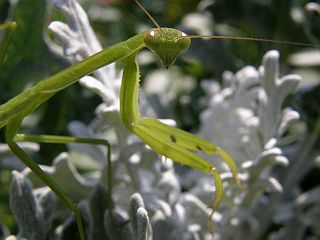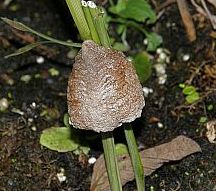
10 October 2008
This warm fall weather is the last hoorah for bugs. Some of them are searching for crevices to crawl into. Others are mating and laying eggs. There’s not much time left before winter, so they’re getting ready.
Unfortunately, my office has become a favorite overwintering site for alien insect species. They sneak through the cracks around my office window, then crawl and fly around until I can’t take it any more.
A few years ago I was invaded by Asian lady beetles (harmless ladybug look-alikes). This year it’s Asian stink bugs. Lady beetles are kind of cute in small numbers but even one stink bug is too many. The battle is on!
Perhaps I need a bug that will eat them. Maybe a praying mantis? My coworker, Jenny McGrail, says she has a lot of them in her yard right now. Should I try one? Or are they invading too?
No, they’re just being conspicuous so they can be promiscuous. 😉
Praying mantis adults can’t live through the winter but their eggs do, so they have a burst of mating activity in autumn. Mantids are normally hard to find but that changes in mating season. Unlike cicadas and crickets who call to attract a mate, mantids use their eyesight. They hang out in likely feeding areas and try to be noticeable. I’m sure they don’t want us to see them but it’s hard for such a large insect to advertise for a mate without being seen by everyone.

Though there are 20 native mantids in North America they all live south of here so it’s likely that Jenny’s bugs are Asian too. Chinese praying mantises were imported to eat agricultural pests, as were Asian lady beetles. Happily the mantids are not as annoying as the lady beetles…
…unless you bring an egg mass indoors.
If you do, you’ll be overrun by them unless you take precautions. The egg masses, like the one pictured at right, contain up to 400 eggs that hatch after several weeks of warm weather. It’s always warm indoors so they’re going to hatch inside – ready or not!
If you bring an egg mass indoors, my friend Marcy suggests keeping it in an open jar with a paper towel securely fastened over the opening with a rubber band. And store the jar in a cold place. Better safe than sorry!
(Thanks to Marcy Cunkelman for her photos of a praying mantis and its egg mass.)
Your post made me smile today. It reminded me of the time my mother brought in bitter sweet to decorate the fireplace mantle. We came home one evening to find a large number of infant praying mantis on our cathedral ceiling. We had to sweep them down and they drove the cats crazy. From that time on, more care was given to bringing the wild outdoors in.
Another interesting and informative post. Your comment about mantis making themselves conspicuous during mating season made me remember a Steelers @ Redskins preseason game a few years ago. Now you might be wondering what a football game could possibly have to do with praying mantids (unless you were watching that game at the right time). During the game the cameras caught site of a fan sitting somewhere in the stands with (no joke) a praying mantis sitting on his hat. The announcers were even talking about it and speculating if the guy even knew it was there. I actually thought it was fake until I saw it move. How it came to be there or what it was doing there is anybodies guess I suppose.
Chuck Tague tells me there’s an additional problem if you let praying mantises hatch in winter. Mantids are insect-eating insects so if they hatch when there are no other insects to eat, they eat each other. Eeewww!